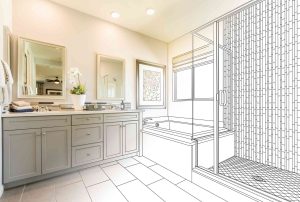Hiring a professional for home remodeling work can be a frustrating process for a homeowner. It’s probably rare for you to deal with large-scale home repair or construction contracts, yet you’re facing a contractor who likely issues several such contracts each week. With this disparity in experience, it’s easy to feel like the deck is stacked against you as you evaluate and negotiate contracts with a pro.
But you can quickly gain confidence by learning the basics of the two ways in which professional contractors estimate costs when creating contracts: fixed-price proposals (also known as bid proposals), and estimate proposals.
-
Single flat-rate price to complete the work
-
Also called bid-style proposal or all-inclusive pricing
-
Easier to understand
-
Less transparent
-
Contractor usually bears cost overruns
-
Usually for smaller projects like dishwashers or water heaters
-
All labor and material listed in detail
-
Also called a time-material or cost-plus contract
-
More complex to understand
-
More transparent
-
Homeowner bears cost overruns
-
Typically for larger projects like additions or room remodels
Fixed-Price Proposals
A fixed-price proposal is one in which the contractor views the situation, assesses the amount of work and materials that are required, then quotes a single flat-rate price to complete the work. This type of proposal is also called a bid-style proposal or all-inclusive pricing proposal.
The fixed-price proposal is almost always what is used with smaller projects. The occasional one-off repair or small remodel projects, such as water heater installation, dishwasher repair, or even floor installation, is simple enough that it is quite easy for a contractor to predict his own costs and quote you a flat bid for the work.
Be aware, though, that contracts based on a fixed-price proposal will still include a built-in contingency fee that protects the contractor’s profit margin. Often this contingency is known only to the contractor. It amounts to an extra markup that allows the contractor to protect their profit even if unforeseen circumstances arrive.
This contingency represents a normal, even necessary, part of doing business as a contractor. If the contingency is not used, this essentially becomes additional profit for the contractor.
There is nothing illegal or unethical about this arrangement, though it does make sense for you to keep an eye on the materials being used in the work. The bid and contract will itemize the materials to be used, and any downgrade in materials should be discussed and approved by the homeowner.
You will have the opportunity to see and make choices about materials and should be consulted whenever changes become necessary.
-
Guaranteed cost
-
Less risk to homeowner of extra charges
-
Easy to understand
-
Contingency limit
-
Possibility of lower grade materials
-
Difficult to compare between contractors
Pros and Cons
Pros
Fixed-price (bid) proposals guarantee a specific job for a specific price, making the process simple and giving you greater peace of mind.
If the project costs increase, the contractor will, to some degree, absorb them with the contingency. This is why the bid is sometimes referred to as an all-inclusive bid. The homeowner is not accepting the risk for minor exclusionary items. Knowing that project costs not likely to spiral out of control, you can better develop your budget.
Bid proposals are the most common and thus may be the most comfortable type of proposal for many homeowners.
Cons
There is a limit to unexpected costs that can be covered by the contingency. For example, a flooring contractor cannot be expected to repair floor joists if it is discovered that they are in poor condition. The contractor will either do this as a separate project via a change order, or you have the option to hire another person to do the work.
A contractor may be motivated to purchase the least expensive materials and hire the least expensive subcontractors. While cheap does not always translate to lower quality, it sometimes does. In fact, the term contractor-grade (or builder-grade) is widely used to refer to minimally acceptable, inexpensive building materials.
Fixed-price proposals make it harder to compare different contractors because items may be listed differently.
Estimate Proposals
In an estimate-style proposal, every labor activity and material in the project is listed in precise detail. You are billed for the materials used, actual hours worked, and work performed by subcontractors. The contractor’s fee is expressed in the form of a percentage of the project cost. This type of contract is also called a time-material or cost-plus contract.
These contracts are the most transparent since you will see very clearly how much profit the contractor is making. But these contracts can be very large and complicated, since they may list hundreds of different line items. Nothing will be left out—not even peripherals such as portable toilets, roll-off dumpsters, permits, and debris pickup.
Estimate proposals are characteristic of larger-scale projects such additions or home building. In fact, due to the complexity of these projects, it would be nearly impossible to issue a fixed-price proposal for such work.
When assessing estimates from different contractors (standard advice is to solicit three bids), these types of contracts can be easier to compare, since the items should match up, one for one.
-
Labor and materials separated
-
Closer control
-
Transparency
-
Contractor may choose higher priced materials
-
Costs can spiral
-
Contractor’s fee is factored from the project cost
Pros and Cons
Pros
As the homeowner, you may prefer billing that clearly identifies labor time and materials, since there is nothing protected by a contingency fee. You will pay only for the work done and the materials used—plus a set percentage of markup for the contractor.
If you like having closer control over a project, this type of contract is best for you. Unlike the fixed-bid proposal, where you essentially hand over all pricing matters to the contractor, with an estimate proposal you can change parts of the estimate as time goes on with change orders.
Estimate proposals represent the ultimate in transparency. As the homeowners, you see all of the moving parts related to the project, no surprises.
Cons
A contractor has less incentive to shop around for lower-priced materials and subcontractors. A contractor may choose a higher-priced subcontractor over a lower priced one simply because the contractor likes working with one over the other.
This type of contract comes with some risk, as it is easy for costs to spiral due to unforeseen circumstances. A homeowner needs to be willing to offer hands-on involvement in order to control costs.
Because the contractor’s fee is factored from the project cost, the contractor stands to make more money if costs are higher. In other words, the higher the price of the project, the greater the contractor’s commission.
Read the full article here














